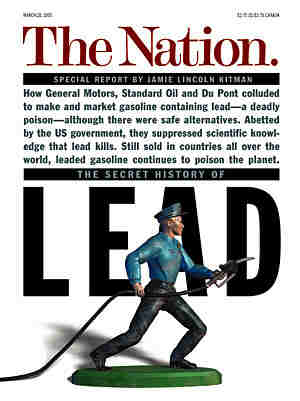 |
|||
| , 2000, ISSN 1324-6011 Incorporating Lead Aware Times ( ISSN 1440-4966) and Lead Advisory Service News ( ISSN 1440-0561) The Journal of The LEAD (Lead Education and Abatement Design) Group Inc. |
|||
|
About Us
|
Hidden History of Leaded Gasoline Reveals Industry Conspiracy to Conceal Dangers Lethal Product Still Marketed Throughout The World Graphic from front cover of The Nation reprinted with the kind permission of artist Mirko Ilic of Mirko Ilic Corp, New York.
Moreover, 14 years after the federal government banned lead from gasoline sold in the US, the American company, Ethyl, and the British company, Octel, are still selling leaded gasoline throughout the developing world and Eastern Europe, despite lead's clearly established dangers, particularly to children. (Ninety-three percent of all gasoline sold today in Africa contains lead.) "The story of how millions of tons of lead, a potent neurotoxin, were spewed into the environment and people's blood for 60 years ranks beside tobacco and the exploding gas tank of the Ford Pinto in the annals of corporate crime in America," said Kitman. "And what's truly outrageous, leaded gasoline continues to be sold around the world." Ironically, Kitman also reveals that leaded gasoline, in addition to being harmful to humans, is also ruinous to car engines, leading to greater engine wear and damage. Since leaded gasoline was phased out in the US, starting in the 1970s, blood levels of lead have fallen almost 80 percent, even as the makers of lead additive denied that their product was responsible for lead in Americans' blood, and at one point sued to prevent EPA and the CDC from even measuring lead in blood. To reveal the hidden history of lead in gasoline, Kitman uncovered documents in the archives of corporate giants like General Motors, E.I. duPont, and Standard Oil of New Jersey (now Exxon), examined records of the US Public Health Service, and conducted dozens of interviews. The year-and-a-half long process revealed a shocking venture, with complicity of the US government, of putting corporate profits ahead of public safety. The parallel to the tobacco industry extends into the arena of junk science, with scientists from the lead additive industry denying, even today, that their product is dangerous. Lead was added to gasoline in the 1920s to reduce engine knock and enable engineers to design cars with higher compression in the cylinders, permitting greater power and efficiency. Other octane boosters that early car designers experimented with included ethyl alcohol, also known as ethanol or grain alcohol. Because ethanol is plentiful and easy to make, however, it was rejected by corporate titans at General Motors and duPont, who needed an additive they could control and profit from -like tetraethyl lead (TEL), which could be patented. (In 1920 duPont controlled 35.8% of GM stock.) And so, despite its manifest dangers and unsuitability for internal combustion engines, TEL became the standard octane booster in gasoline. Among its foremost promoters were Alfred P. Sloan and Charles Kettering of General Motors, remembered today for having founded the prestigious Sloan-Kettering Cancer Center. Early on, prominent health and safety experts, including officials at the US Public Health Service, expressed concern about adding TEL to gasoline. One expert called TEL "a creeping and malicious poison," and in 1922 the Surgeon General himself expressed concern in a letter to GM interim president Pierre S. duPont. A special committee of health and safety experts was formed to investigate the dangers of TEL, and in 1926 the committee found "no good grounds" for banning TEL. Significantly, however, the committee cautioned that if leaded gasoline became widespread, further studies would be warranted. But for the next 40 years, all research of TEL's health effects would be underwritten by GM, Standard Oil, duPont, and trade associations for the lead industry. Since the 1920s, an estimated 7 million tons of lead burned in gasoline in the US remain in the soil, air, water, and bodies of living organisms. Worldwide, modern man's lead exposure is 300 to 500 times greater than background or natural levels. Children are the first victims of leaded gas. Because of their immaturity, they are susceptible to systemic and neurological injury, including lowered IQs, learning disabilities, hyperactivity, and behavioral problems. In adults, elevated lead levels are related to blood pressure increases, cardiovascular disease, and heart attacks. Lead expert Dr. Paul Mushak, in a 1988 report to Congress, estimated that 68 million children had toxic exposures to lead from gasoline from 1927 to 1987. A 1985 EPA study estimated that as many as 5,000 Americans were dying annually from lead-related heart disease before the lead phase-out in the U.S. An irony uncovered by Kitman is that leaded gasoline is ruinous to car engines, leading to more frequent oil changes and tune ups, piston ring wear, damage to exhaust systems, and camshaft and lifter wear. The damaging effects of lead necessitated the introduction of another gasoline additive, ethylene dibromide [EDB], which created even more environmental problems. When unleaded fuel was required in the US, EDB manufacturers found a new use for the chemical, as a pesticide. EPA banned EDB in 1974. For further information or to interview Jamie Lincoln
Kitman, contact Danielle Veith at
+1 212-209-5426 or Peter Rothberg at: also available at |
||
|
About
Us | Contact Us
| Council
LEAD Project | egroups | Library
- Fact Sheets | Home
Page | Media Releases | Newsletters Q & A | Referral lists | Reports | Site Map | Slide Shows - Films | Subscription | Useful Links | Search this Site |
|||
|
Last
Updated 03 November 2011
Copyright © The LEAD Group Inc. 1991- 2011 PO Box 161 Summer Hill NSW 2130 Australia Phone: +61 2 9716 0014 |
|||
